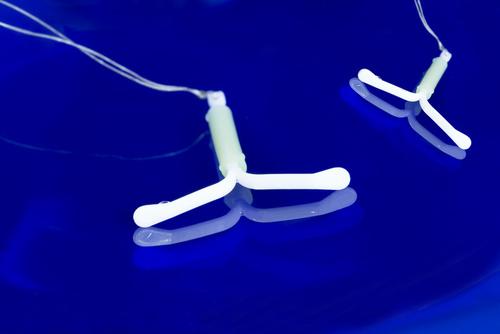 IUD contraception method requires insertion of a T-shape device into the uterus.
IUD contraception method requires insertion of a T-shape device into the uterus.An intrauterine device (IUD) used in conjunction with a Foley catheter appears to be better than the Cook balloon stent at preventing the reformation of intrauterine adhesions, according to a new study.
The prospective, randomized, controlled study included 118 women with Asherman’s syndrome. Participants were randomly assigned to receive either the Cook balloon intervention (n=62; mean age, 31.69±5.268 years) or the IUD-Foley catheter combination (n=56; mean age, 32.63±6.125 years). Endpoints included postprocedure recurrent adhesions, restoration of the menstrual, cycle and reproductive measures, among others.
The rate of recurrent adhesions in the IUD-Foley catheter group was 19.6 percent, which was significantly lower than that in the Cook balloon arm (38.7 percent; p=0.024) [Reprod Biomed Online 2020;doi:10.1016/j.rbmo.2020.02.013]
Similarly, more women in the IUD-Foley catheter arm reported menstrual improvements after surgery (82.1 percent vs 66.1 percent; p=0.048). A normal menstrual pattern was likewise reported in a significantly higher proportion of patients who were given the IUD-Foley catheter combination intervention (p<0.05).
Pain score after surgery, measured according to the numerical rating scale, was also better in those who received the combination approach (2 vs 3; p<0.01).
On the other hand, the use of IUDs with Foley catheters did not demonstrate better reproductive outcomes. Pregnancy occurred an average of 13.4 months after surgery in a total of 71 participants. The resulting overall pregnancy rate was 60.2 percent.
This figure was not significantly different between the Cook balloon stent and IUD Foley catheter combo groups (61.3 percent vs 58.9 percent; p=0.852).
Twenty-three participants conceived through in vitro fertilization, while the others had spontaneous pregnancy, which occurred with comparable rates between the Cook balloon and the IUD-Foley groups (41.9 percent vs 39.3 percent; p=0.770).
Sixty-four of these pregnancies resulted in live births, which was likewise similar between the treatment groups (p=0.460). The same was true for the miscarriage rate and term deliveries.
“[O]ur study is the first randomized, controlled trial that was designed to compare the efficacy of the COOK balloon stent and an IUD plus a Foley catheter for preventing adhesion reformation,” the researchers said. “In our study, the application of an IUD with a Foley catheter was more effective in reducing adhesion reformation.”
They added that while there may have been no demonstrable differences in the live birth rate, improvements in menstrual volume may be a positive reproductive indicator.
“However, menstrual changes may have a limited role as an outcome, as they do not necessarily correlate with the live birth rate,” the researchers said. “Given the similar reproductive outcomes in the study and the limited number of included patients, no solid conclusion can be drawn about the live birth results.”
A larger study designed to evaluate the efficacy of these methods may enable further detection of this outcome, they concluded.